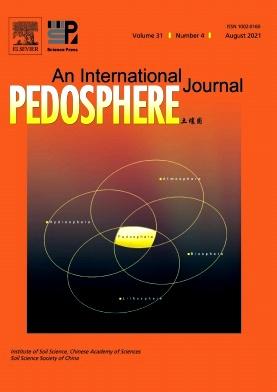Biochar addition affects soil carbon stock by altering keystone fungal species and necromass abundance and oxidase activities in forest and paddy soils
IF 7.3
2区 农林科学
Q1 SOIL SCIENCE
引用次数: 0
Abstract
Fungi play a crucial role in the utilization and storage of soil organic carbon (SOC). Biochars can potentially influence soil carbon (C) turnover by mediating extracellular electron transfer, which can be facilitated by fungi. However, the effects of biochar and soil type on the community, abundance, enzyme secretion, and necromass of fungi mediating SOC storage remain unclear. A mesocosm incubation experiment was conducted using forest and paddy soils from southern China to study the impact of biochars pyrolyzed at low (300°C, BL) and high (700°C, BH) temperatures on fungal abundance, community composition, necromass abundance, and C-degrading enzyme activities. The SOC retention ratio was higher under BL (84.0%) than under BH (76.3%). Addition of BL increased fungal abundance in the forest soil by 230%. In contrast, addition of BH decreased fungal abundance in the paddy soil by 20.8%. Biochar addition affected fungal necromass accumulation and oxidase activity and regulated SOC turnover. The high available C content and moderate liming effect of BL significantly increased fungal abundance and necromass abundance in the forest soil compared to the paddy soil. Moreover, after 16 weeks of incubation, BL addition decreased peroxidase activity by 32.1% in the forest soil due to the higher C use efficiency of fungi (i.e., the enrichment of Talaromyces, Umbelopsis, and Trichoderma), decreasing C-degrading enzyme secretion and reducing SOC degradation compared to the paddy soil. However, BH addition increased the Fusarium abundance, which regulated the polyphenol oxidase activity and promoted SOC degradation in the paddy soil. We concluded that biochars could alter the soil environment and extracellular electron transfer to mediate fungal necromass content and C-degrading enzyme activities, thus affecting SOC storage in the forest and paddy soils.
生物炭的添加通过改变森林和水稻土壤中的关键真菌种类和新菌体丰度以及氧化酶活性来影响土壤碳储量
真菌在土壤有机碳的利用和储存中起着至关重要的作用。生物炭可以通过介导细胞外电子转移来潜在地影响土壤碳(C)的周转,真菌可以促进这一过程。然而,生物炭和土壤类型对真菌群落、丰度、酶分泌和坏死块介导有机碳储存的影响尚不清楚。以中国南方森林和水稻土为研究对象,研究了低温(300°C, BL)和高温(700°C, BH)热解的生物炭对真菌丰度、群落组成、坏死团丰度和C降解酶活性的影响。土壤有机碳保留率(84.0%)高于土壤有机碳保留率(76.3%)。添加BL可使森林土壤真菌丰度提高230%。相反,添加BH使水稻土真菌丰度降低了20.8%。添加生物炭影响真菌坏死块积累和氧化酶活性,调控有机碳周转。与水稻土相比,林间土壤有效碳含量高,石灰化效果适中,显著提高了森林土壤真菌丰度和坏死菌丰度。此外,在16周的培养后,由于真菌对C的利用效率更高(即Talaromyces、Umbelopsis和Trichoderma的富集),与水稻土相比,添加BL使森林土壤中过氧化物酶活性降低了32.1%,减少了C降解酶的分泌,减少了SOC的降解。而添加BH增加了水稻土镰刀菌的丰度,从而调节了水稻土多酚氧化酶活性,促进了水稻土有机碳的降解。结果表明,生物炭通过改变土壤环境和胞外电子传递,调节真菌坏死块含量和c降解酶活性,从而影响森林和水稻土壤有机碳储量。
本文章由计算机程序翻译,如有差异,请以英文原文为准。
求助全文
约1分钟内获得全文
求助全文
来源期刊

Pedosphere
环境科学-土壤科学
CiteScore
11.70
自引率
1.80%
发文量
147
审稿时长
5.0 months
期刊介绍:
PEDOSPHERE—a peer-reviewed international journal published bimonthly in English—welcomes submissions from scientists around the world under a broad scope of topics relevant to timely, high quality original research findings, especially up-to-date achievements and advances in the entire field of soil science studies dealing with environmental science, ecology, agriculture, bioscience, geoscience, forestry, etc. It publishes mainly original research articles as well as some reviews, mini reviews, short communications and special issues.
 求助内容:
求助内容: 应助结果提醒方式:
应助结果提醒方式:


